#13: Daybreak, by Maxfield Parrish
Daybreak, by Maxfield Parrish
This analysis copyright 2009 by Scott M. McDaniel
The Image
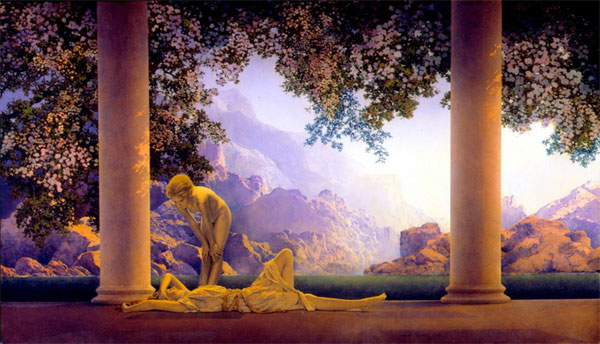
Daybreak was the 20th century’s single most popular print in America. According to Alma Gilbert, the House of Art ,which handled the printing, estimated that 1 out of every 4 homes in America had a copy. When I first started reading up on this painting I constantly ran across the term “Dynamic Symmetry.” It was the system that Parrish had used to lay out the composition and arrange the elements. When I looked around for a good description, I didn’t turn up much. However, Jay Hambidge’s book on it from 1920 was available through Amazon, so I ordered it. This is, I believe, the same book that Parrish would have read.
Since Dynamic Symmetry is so important to the composition, I’m going to focus on that rather than on palette or other topics. (Some prints of the painting are quite blue-green. I’m showing the proper colors here, though there is always the question of reproducing color of older works.)
“Dynamic” Composition
It took me a while to really understand what was meant by composition. I kept trying to make it more complicated and mysterious than it is. Simply, it’s the arrangement of things in your picture. Or, to be precise, the arrangement of lights and darks. People talk about dynamic and static compositions, organic compositions, and balanced compositions. Something placed right in the center of the picture will be static, they say. What they mean is “visually uninteresting.” (If you think about it, every painting is static – none them actually move.)
The question, then, is how to arrange things in your picture to make it visually exciting, or “dynamic.” Look at enough examples and you’ll see that some layouts really do work better than others. Though I haven’t seen anyone even try to explain why these compositions work, they have worked out guidelines for them. You can see these same principles of proportion and arrangement in natural objects from snail shells to galaxies. Why do we find paintings that follow these guidelines pleasing? I think we unconsciously judge things that follow the proportions as more natural than other man-made objects. But really, who knows?
Ancient Greeks and Egyptians used these principles of proportion, but then their use disappeared. In 1920 Jay Hambidge published a book called “The Elements of Dynamic Symmetry” that brought them back to artists and designers. You need high school level geometry to understand them, but not more than that.
The Basic Pieces
Just like we can break the human body down into its cylinders, blocks, spheres, and cones, we can break a rectangle down to component shapes. That is what Dynamic Symmetry is all about – subdividing the square or rectangle into smaller, pleasing shapes. Here are the basic pieces:

The square. This is our starting point. All sides are the same. Let’s make up a new unit of measurement. Rather than inches or centimeters, we’ll call it the “Parrish.” The square above is 1 Parrish long on each side. From it, we can make a set of special rectangles that we can use to subdivide space pleasingly. This series of rectangles all have a side that is 1 Parrish. The top and bases are the square roots of 2, 3, 4, and 5. I’ll use the Pythagorean Theorem to explain why in a minute, but even without that you can still create them from the square easily enough.
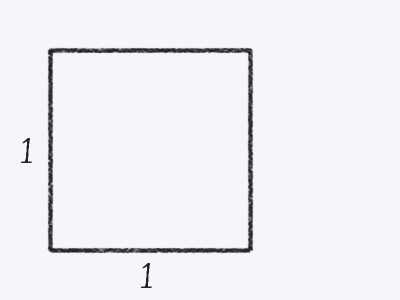
Take the square and create a diagonal through it. Treat the diagonal like the radius of a circle, and follow the circle down until it matches the base of the square. Finally, create a rectangle with a base as long as the square’s diagonal. If you recall, “A squared plus B squared = C squared.” A and B are the sides of the square, and C is the diagonal (hypotenuse). Since 1 squared is just 1, we have 1 + 1 = 2. So, when we rotate the diagonal down to be the base of the new rectangle, we have a a rectangle that is 1 Parrish tall and the square root of 2 Parrishes wide.
OK, if you just glazed over right there it’s time to come back. Even without following the numbers, hopefully you can see the visual relationship between the square and this “root 2 rectangle.” To get the rest of the rectangles, you keep going.

We can also create these rectangles inside a square, like this.
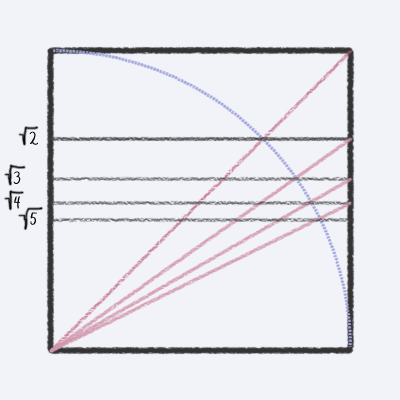
Put the diagonal in the 1 Parrish x 1 Parrish square like we did before. Use one of those corners as the center and put a quarter circle inside the square. See where the diagonal meets the circle? Draw a line there to make a rectangle inside the square. That’s your root 2 rectangle. Next, put a diagonal through the root 2 rectangle and see where it meets the circle. Put in another line to make a smaller rectangle inside the first. That’s your root 3 rectangle, and so on.
What you should see here is that the basis of Dynamic Symmetry is using diagonals and circles to expand or subdivide your space. If you put the pieces of your drawing along these diagonals, curves, and lines, your illustration will have a natural, “organic” composition.
The Golden Rectangle
Hambidge says that there are two shapes that stand out even from the others as the key to using Dynamic Symmetry. The first is the root 5 rectangle from above. The second is the “golden rectangle.” His name for it is the wonderful “Rectangle of Whirling Squares.”
Let’s back up a second. There’s this special sequence of numbers called the Fibonacci sequence. If you start with 0 and 1, keep adding the current number with the one before it to get the next one:
0, 1, 1, 2, 3, 5, 8, 13, 21, 34, 55, …
Especially as you get to the higher numbers, whenever you divide a number into the one that came before it you get one of these irrational, never-ending decimals like pi. This one is called phi ( ϕ ) and we can approximate it with the number 1.6180. This is one of those numbers that shows up in nature everywhere, but I’m not going to go into that here. Instead, let’s look at a rectangle that is 1 Parrish tall and 1.6180 Parrishes wide.

In a weird bit of “math-fu,” if you take two golden rectangles and overlap them so that there’s a square in the middle, you have a root 5 rectangle.

So, that’s it for the Dynamic Symmetry summary. I left out a lot of course, but these are the basics. If something’s not clear, fire away in the comments or in a message. The downside of Jay Hambidge’s book was that it didn’t apply these principles to any illustrations so we could see them in action. Since that’s what this column is all about though, that’s where we’re going next.
The Composition of Daybreak
Now, I picked up Hambidge’s book specifically for this column, so I’m far from a Dynamic Symmetry expert. That said, it didn’t take long to start finding examples of it in this painting. My first thought was, “I’ll bet the dimensions of the painting match the golden rectangle!” So, I reduced the image to 100 pixels tall, expecting the width to be about 161.8 pixels wide. Oops, no dice. It was about 180 pixels.
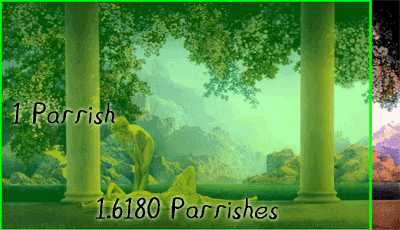
Next, I decided that he’d probably used one of those root rectangles as the aspect ratio. So, I reduced it a bit and made a square on one end 1 Parrish tall by 1 Parrish wide. Using this as the starting point I worked out the root rectangles. Starting with a square on the left side that is 1 x 1 Parish, we see that the root 2 rectangle doesn’t fit. The root 3 rectangle, though, is quite close. (Actually the painting’s dimensions are 26.5 inches by 45 inches, so 1 Parrish = 26.5 inches.) If the painting is 26.5 inches tall, the width for an exact root 3 rectangle would be 45.9 inches. Notice that the diagonals from each step nicely frame the standing figure, touching the top of her head, going through her shoulders, and her waist.
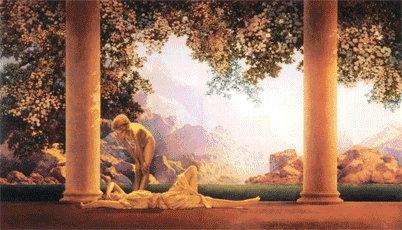
Here’s something interesting about the root 3 rectangle. You can look at it as combination of the square you started with and 2 smaller rectangle stuck onto the end. If you make a square on the end of those smaller rectangle, what you’re left with is a that square and a smaller root 3 rectangle.
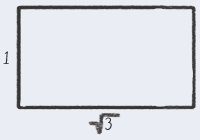

When we overlay that diagram on the painting, we see that the foliage ends right on the lines of those small squares. On the left side the foliage takes up the upper part, which is a root 3 rectangle itself. On the right side the foliage takes up a square while the background is the root 3 rectangle.
The Center Square
Since Dynamic Symmetry is all about subdividing in organized ways, I thought it might make sense to make the root rectangles inside the center square. The first thing to do is mark out the square and put in the quarter circle.

Before we go any further, see how the circle makes an arc that follows the reclining figure’s leg and dress and then the standing figure’s torso and head? Basically it’s dividing the square into foreground and background.
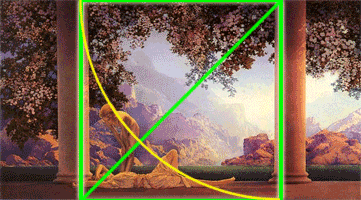
So now that we have the arc and the diagonal, we can create the root 2 rectangle. That passes through the standing figure’s knees and wrists, and just above the reclining figure’s knee. Carrying on, we see that the root 3 rectangle passes through the standing figure’s shoulders and eyes while the root 4 rectangle touches the top of her head. Even the background foliage looks like it’s radiating out from that upper square point toward the standing figure.
Of course, the square has four corners and any of them can be the center of a circle. Here are a couple of other diagrams.

If the lower left corner is the center of the circle, we see that the reclining figure’s knee touches the diagonal of the root 4 rectangle.

When the lower right corner is the center of the circle, we see that the reclining figure’s foot touches the Root 4 rectangle’s diagonal.

When the upper left corner is the center of the circle I’d expected the mountains to follow the diagonals, but that’s not really the case. I’ll get to that in a minute, but first take a minute to look at how all these diagonals together frame the figures. Together with the diagonals for the entire painting (not just the center square) those figures are quite precisely defined. Take the guide lines away, though, and they’re quite natural and relaxed – not stiff at all.
Those Troublesome Mountains
One of the concepts that Hambidge talks about is the complement of a rectangle. That is, if you have a rectangle, the complement is the other rectangle you have to add to it to get a square. One thing he says that artists often forget is that their canvas is part of a larger surface, and you can make compositional decisions based on that larger space. Look at this:

What I’ve done here is completed a square. The painting takes up the lower part. If you make a root 2 rectangle inside, you discover that its diagonal lines up quite nicely with the mountains in the background. If you keep going, you get this set of diagonals. They don’t all line up, but you can see that the nearer set of hills lines up with the diagonal of the root 5 rectangle.

Another concept Hambidge talks about is the reciprocal of a rectangle. To make its reciprocal, put a diagonal line through the rectangle. Then, from one of the other corners make a line at right angles to that diagonal. Put a vertical line where this new line meets the rectangle’s edge and you’ll see a smaller rectangle that is the original’s reciprocal. Parrish used this method of right-angled diagonals to figure out how wide to make the columns.

Wrapping Up
Is your brain full yet? So far I’ve made it about two-thirds of the way through Hambidge’s book. I’m certain that what I’ve outlined here is just the beginning. The horizon line, for example, and the line between the grass and the floor are not accidental, but I haven’t yet figured out why they’re in that position. (If you know, please leave a comment or a message – I’ll update the page here and give you credit.)
We’ll get to Lee Moyer’s Elements of a Successful Illustration in a moment, but first I wanted to show you one of the preparatory sketches that Parrish did while working out Daybreak. You can see how he was working out the spacing and proportions.
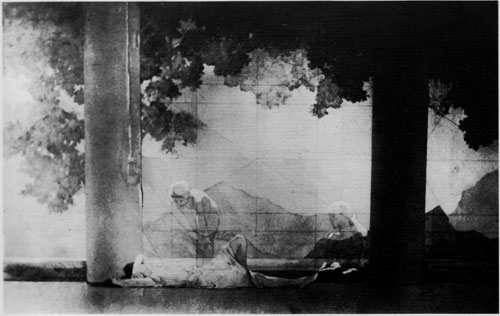
You can also see that Parrish planned a third figure. Parrish collector Alma Gilbert speculates in the book Maxfield Parrish: The Masterworks that because his long-time model and probable mistress Susan Lewin posed for that third figure, Parrish’s daughter asked him to remove her. His daughter Jean was 11 at the time and was the model for the standing figure. In the end, however, Parrish used Lewin’s body as the model for the reclining figure and gave it a different face. That face belonged to Kitty Owen, the granddaughter of William Jennings Bryan. (When the original painting was sold, the buyer remained anonymous and it disappeared from the public scene for nearly 50 years. It turned out that William Jennings Bryan had bought it for a fairly high amount, and because he had political ambitions didn’t want it known that he’d spent that kind of money on a painting.)
All right – time to do the elements.
Focus: While we focus on the two figures, we’re also meant to take in the entire scene. There are lines and pointers that guide our eye to them, but not as many as in some of the other paintings we’ve looked at.
Composition and Design: It’s put together with Dynamic Symmetry, as I’ve been explaining. Even without that level of analysis, though, we can see that the columns frame the figures and the idyllic landscape behind.
Palette: The palette is generally warm, particularly in the foreground. The cool colors in the trees aren’t very saturated. The blues of the sky aren’t that saturated either. Sometimes you will see very blue-green versions of this painting. That is a printing error – the warmer tones that you see above are closer to the original.
Value: The brightest area with the most contrast is the sky against the right column. So, one of the first things we see is the mountain range, and then we come over to the figures in the foreground.
Mass: Values also represent form and mass. The nearest rocks and mountains are good examples of this.
Texture: The rocks and mountains provide a rough texture that contrasts with the smooth textures of the columns, standing figure, and floor. The reclining figure’s clothes provide a different kind of texture. Finally, the flowers and foliage have yet another texture.
Symbolism: The columns, nudity, and reclining figure’s clothing suggest a Classical Greek setting. This lines up nicely with the use of Dynamic Symmetry because the Greeks brought it to its heights according to Hambidge.
Micro/Macro: I see a lot of detail in the mountains and foliage. As in James Jeans’ The Last Castle, all that detail merges into a texture. The smoothness of the foreground contrasts against that and brings the figures forward.
Ornament: There is a little bit of ornament in the reclining figure’s wrap and at the bases of the columns. Perhaps you could consider the nature background to be ornament.
Narrative: Though narrative isn’t the most important aspect of the painting, we can tell there is some sort of interaction going on between the two figures. Has the standing girl just come from playing outside to check on the reclining woman? Is she waking her up?
Juxtaposition: I find the straight, clean lines of the architecture to be a good juxtaposition against the texture and diagonals of the background.
Stylization: Daybreak is mostly realistic.
Character: The poses and expressions show two people who are relaxed and worry-free.
Tension: There’s very little tension in the painting, which I think is the point. Though, I do find myself wondering how that reclining woman can be so happy and relaxed on a stone floor.
Line: The only clear edges are the verticals of the columns and the horizontals of the floor and horizon.
Research/Reference: Parrish spent quite a long time on this painting – about two years. Aside from the sketch above, I also found photos of Jean Parrish modeling for the standing figure. Also, see Parrish’s own comments about the painting below.
Vignette: The warm tones of the figures and foreground architecture against the cooler and less saturated background tones give a clear silhouette to the foreground elements.
Perspective: Parrish uses scale and atmospheric perspective to get the sense of space and openness we see.
Fun: Here is what Parrish wrote to his publisher in March 1921, “As to the ‘great painting,’ its beautiful white panel is always on the wall before me, and I am thinking great things into it. I have thought so many beautiful things into it that it ought to make a good print just as it is. Have patience!” Two years later in April 1923 it went to the printers for reproduction.
That’s it for this time. I’m sure I just scratched the surface. Next time I’ll take on a cover from Strangers in Paradise by Terry Moore.
Did it ever occur to you that you are overanalyzing it? What if the artist just painted it because it was appealing to the eye? Not every artist is as anal retentive and analytical as you seem to assume they are!
Dear Scott,
Thank you for an excellent explanation of the basics of Hambidge’s dynamic symmetry. I came across his concepts in a paper written by Karyl Knee and have been trying to learn more in order to use this design approach in the Byzantine iconography that I am doing.
I’ve drawn designs for several icons based on recensions but knew that something was “missing”. Your column with the helpful diagrams and clear text has motivated me to pick up Hambidge’s book and to start studying.
If you have made any more insights into Parrish’s work, or anything else related to dynamic symmetry, I’d love to know about them.
With thanks,
Deb
Thank you very much for this. It’s such fun to read, not just for how Parrish uses the section, but as a translation into reality of Hambridge’s words.
Did you try beginning the original square from the right? I tried, without much success, to do it by eye, as I read. I wondered what it might illuminate.
I have worked with the golden section in architecture for many years. The information about historic – and current – use of these proportions in construction and design is scant. I think there is much more to be discovered and described.
Many artists do paint based on what’s appealing to the eye. It’s often hard to know how systematic they were. In Parrish’s case, though, he explicitly stated that he used Dynamic Symmetry as the foundation for Daybreak. I’ve returned the book to the library but could certainly find that attribution for you if you like. So, in this case I’m pretty comfortable saying that he did use the system and it’s not over-analyzed. In particular, look at the study at the end with all of the different divisions and diagonals mapped out.
I certainly realize that not every artist is not as analytical or AR as these analyses. However, I think they’ve largely internalized the principles I’m looking at. They may be doing things by intuition, but only because they’ve developed that intuition through art school or self-study. This blog is part of my attempt to do that for myself.
@Deb – I hope you like his book. I found it straightforward and clear for a math book written in the ’20’s. It’s better than a lot of math books today. I don’t have a whole lot more for you, though I think it would be quite helpful in iconography. Take a look at these links for a couple of interesting Youtube movies involving the concepts, though:
http://www.youtube.com/watch?v=kkGeOWYOFoA
http://www.youtube.com/watch?v=A7ogkIFJMT0 (How the band Tool based a song on the Fibonacci sequence)
@Jane – I did look at it with the square on the right and didn’t find much. The diagonals did intersect with the standing character, though.
Thank you very much for the above explanation. I have Hambridge’s book but it is difficult to understand. You really did explain in a way I can follow and use for my paintings. Have you analyzed any other paintings in this way? Thanks again.
@Linda – I’m glad you found it helpful. I haven’t looked at other paintings using Dynamic Symmetry, but I’ve read that a sci-fi illustrator named Hans Bok used it extensively at Parrish’s urging.
That is really a terrific example. Thank you. Isn’t the horizon line (running through the standing figure’s ankles) the same line as would be the root 5 line if the diagonals were started from above?
I got to your site after visiting the linesandcolors.com site and following links about James Gurney.
Thanks, again.
Milton
[…] In researching this piece further, I came across an interesting analysis of it by Scott M. McDaniel. Jay Hambridge developed a theory on the concept of dynamic symmetry invented by the ancient Greeks […]